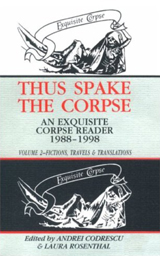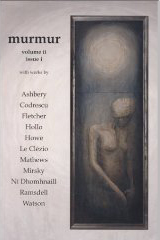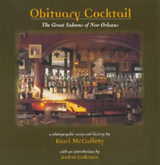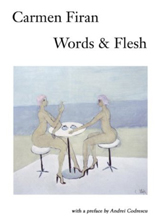ANDREI CODRESCU
The Multi-Identity Man
Abstract: The main goal of the present study is to sketch the multi-faceted personality of the Romanian-American writer Andrei Codrescu. Significant aspects derived from both his biographical background and interviews to various literary magazines will help in determining the author’s profile: a person released from the obsession of a unique cultural and linguistic identity and fully integrated into the new context of a global culture.
1. Biographical Guidelines
Andrei Codrescu (b. Perlmutter), a Romanian-American poet, novelist, essayist and translator of Jewish origin, was born on December 20, 1946 in Sibiu, Romania. After having graduated from “Gheorghe Lazăr” High School in his native town (1965), he leaves the country along with his mother, as part of a ransom program initiated by the Israeli government. Following very brief relocations to Rome and Paris, the writer eventually settles in the United States, where he starts learning English. For a couple of years he will live in New York City, where he meets the most prominent figures of contemporary American poetry: Ted Berrigan, Robert Creeley, Joel Oppenheimer, Paul Blackburn, Anne Waldman, Lewis Warsh, etc. After having grasped the basics of the adopted language, Codrescu becomes acquainted with the artistic entourage around the New York School, an informal group of American poets, painters, dancers and musicians active in the 50’ s and 60’ s, who drew inspiration from Surrealism and the contemporary avant-garde art movements. As part of this artistic circle, he starts publishing in one of the School’s mimeographed magazines (The World), in parallel with his literary contributions to Work, a ‘mainstream’ magazine. This early experience as an American writer is charmingly evoked by Codrescu in an interview given to Constantin Pricop:
“The World was the monthly magazine published by St. Marks Poetry Workshop in New York, the main publication of New York School movement. It was edited by Anne Waldman and Lewis Warsh, with the help of my friend and mentor, Ted Berrigan. Work was a ‘serious’, quarterly magazine, promoting ‘academic’ poets, which made “Tristan Tzara’ s” unpublished poems to be taken seriously. At The World we used to have a ludicrous attitude and seized any opportunity to defy the mainstream culture, represented by Work.“
In 1970 Codrescu moves to San Francisco “where the psychedelic revolution, the Pacific Ocean and Zen meditation rendered the contemporary experiences more mystical” (Pricop, Sensul diferenței...). Here, he becomes a regular participant in poetry reading sessions at Coffee Gallery, together with Tom Veitch, Terry Patten, Michael Palmer, Aram Saroyan, Pat Nolan, etc.
In 1974, the writer changes residence to Monte Rio, in northern California. Yet— interestingly enough—he fails once again to settle down, as if predestined to perpetual exile in the grand scheme of Life.
There follows a stay in Baltimore over a span of seven years, from 1977 to 1984. During this period, he contributes with an opinion column to The Baltimore Sun, and teaches literature at Johns Hopkins University. Since 1983, Codrescu has been a regular commentator on National Public Radio’s news program “All Things Considered”.
In 1984, the author moves to Baton Rouge, where he becomes a McCurdy Distinguished Professor of English and Comparative Literature at Louisiana State University. Apart from this, he works as the editor of the online magazine Exquisite Corpse: A Journal of Letters & Life. According to his own confession, “the South was, in a way, for me a return to the roots, as here I have found the Balkans’ love of life and southern indolence, associated with a particular attachment for the vernacular language, exhausted in most other regions by television and urban discomfort.”
The writer revisits his native country on two dramatic occasions — in December 1989 and June 1990, respectively — as a reporter for National Public Radio and ABC News. These journeys back home will result in a much acclaimed autobiographical book, The Hole in the Flag (1991), which includes a vivid coverage of the tensions during the Romanian Revolution and the miners’ invasion into the Capital, as well as touching episodes depicting his encounter with the native places, the last surviving relatives, or few of his former schoolmates. In the Preface to the Romanian edition, Vladimir Tismăneanu notices: “this book captures the gloomy political intrigues of those who have unfairly derived benefits from the Revolution, as well as that mixture of heroism, innocence and desperation that made possible the miracle of December 1989.”
2. “I’m an amalgam, a crossbreed...”
Andrei Codrescu started publishing poetry under the pen-name Andrei Steiu, first in his native town (Tribuna Sibiului), and then in Bucharest (Luceafărul, Gazeta literară). It is only in 1967—during his stay in Italy—that he first signs with his current pseudonym a poem published in Revista Scriitorilor Români. It will not be long until the poet will create fictitious biographical ‘masks’ in the manner of Pessoa:
“I conceived a feminist and traditionalist poet, Maria Parfenie, who was published both in exile—in magazines such as Revista Fundațiilor Regale, Limite, Destin —and in the country, in M. R. Paraschivescu’ s Luceafărul. Even Andrei Codrescu, who was somehow more ‘vanguard’ than Maria Parfenie, published in these magazines. The poems were very ‘beautiful’, written in a classical, crystal- like language, with nothing colloquial or informal. [...] They were dark, regretful, sad poems, in memoriam for my adolescence, country, and Romanian language.”
Yet “regrets” will shortly come to an end with the first lyric productions in the adopted language — as the author confesses with a touch of humor: “my first poems in English were written straight on the arms of these girls that I met at Wayne State Cafeteria back in Detroit”. The writer’s “ludicrous attitude” of his early American experience is still visible in the bookish play of projecting the self in the biography of some imaginary poets, under whose names Codrescu publishes several poem cycles: “Julio Hernandez ‘is a Puerto Rican poet in detention, born in the East Side of New York in 1967’ [...]; Peter Boone is ‘an ex- beatnik who, in Vietnam or somewhere else, became a sort of mystic fascist’ [...]; Alice Henderson-Codrescu, ‘whose name I shamelessly borrowed from my wife, is the man turned into a woman—maybe the most unknown woman there has ever existed’; and Calvin Boone is ‘a Dominican monk, Peter’s relative’.”
By means of these heteronyms, Andrei Codrescu “charts a vast existential and cultural territory, located at the junction between Europe and America, between the liberalism of the 60’s and the recession of the next decade”.
Interesting and symptomatic of the manner in which the exiled writer relates to his own identity is the fact that Andrei Codrescu pushes this game of psychological doubling to the ‘fraudulent’ limit of substituting himself with the founder of Dada movement, by attributing Tzara the paternity of several would-be ‘unpublished’ poems:
“I also published in Work a poem cycle ‘by Tristan Tzara’, which had been written by me in English and then translated into Romanian. Tristan Tzara’ s ‘unpublished’ poems were much debated by the critics. The aim, I guess, behind this ‘translations’ was to bridge the gap between the languages, to find a way of justifying my lay knowledge of English.”
Beyond the ludicrous aspect of this postmodern-like bravado, however, one might perceive the grimace of the exiled writer, transplanted into an allogeneous, linguistic and cultural environment, and confronted with the necessity to recreate himself. This process of identity mutation is actually deep-rooted in the author’s own biography — whose Jewish origin had to be concealed in the public space of communist Romania. The carnival-like play of lyric masks was intended to undermine the obsession of a unique identity and, equally important, to legitimate a ‘multi-identity’ ego:
“When I conceived Maria Parfenie, I was already in favor of self-invention. I was born Andrei Perlmutter, I became Andrei Steiu (with the aid of a ‘natural’ anti-Semitic state of mind at home, which would have frowned upon a printed ‘Perlmutter’), and after that, in Italy, I became Codrescu. [...] My other inventions (not only Maria Parfenie, the Romanian poetess, but also the American poets Julio Hernandez, Peter Boone, Alice Henderson-Codrescu, ‘Tristan Tzara’) were, on the one hand, the expression of a skilful schizophrenia, and on the other hand the school where I’ve learned how to imagine the ‘others’: A kind of dramaturgy, if you like, — characters of my auto-pedagogical theater. As for my intention to remain a Romanian author in America — it doesn’t exist! My only intention was to be a poet — how and of what expression, I didn’t know. I think I wanted to be both a Romanian and an American poet.” This sort of nonchalance in front of ‘otherness’ —equally favored by the destination of his exile (i.e. hippie America of the 60’s) and the subsequent evolution of society toward an age of plurilingualism and multiculturalism — facilitated the writer’s access to, and ascension within, the American cultural environment:
“For me, my only fortune was that I wasn’t American, that I embodied differences, oddity, and exoticism. The sense of otherness has been there with me since I was born — I’m Jewish, so I was also different back in Romania. Unfortunately, Romanians see otherness as something menacing. In Romania, the prudence of a child who feels himself ‘different’ makes him hide, wipe out his traces, blur his identity. In 1966 Americans saw otherness as something interesting.”
Being asked by Nicolae Stoie, the chief editor of Astra magazine, what means to the American writer Andrei Codrescu to ‘return home’, he replied: “As a writer, my ‘home’ has always been the language, the language in which I’ve written and lived. I’ve lived in both Romanian and English, and I’m home in both of them. In our time it’s possible, thank God, for a man and a writer to be home in two or five countries, in two or five languages.”
This conclusion — the ubiquity of the concept of ‘home’ by cultural and linguistic expansion — Codrescu reaches once he has grown aware of the disappearance of the ‘outside’, within the political context of the fall of the ‘Iron Curtain’ and the abolition, within the European area, of the great historical dichotomy capitalism vs. communism: “Having escaped ‘outside’ — in the Occident and, eventually, in the United States, where he became a famous poet, essayist, and journalist—Andrei Codrescu first lost his ‘inside’, and today, with the dissolution of the communist Gulag, also discovers the disappearance of the ‘outside’.”
Unlike the majority of his fellow-writers in exile — who take steady pains to preserve their linguistic identity and their affiliation to Romanian culture — Andrei Codrescu opts for the metaphor of the American melting pot in defining his multi-faceted identity:
“Once again, it’s not about two distinct identities: my ‘American’ identity isn’t torn apart from the ‘Romanian’ one — I’m an amalgam, a crossbreed. This amalgam also consists of my Jewish origin, of my childhood in Sibiu, of Transylvania, of all the cities I’ve lived in and all the languages I’ve spoken, including the German and Hungarian of my early childhood.”
From this standpoint, the writer overcomes the ‘nostalgia of origins’ with its inherent tragic echoes, joining— alongside Petru Popescu and other fresher names of our literary exile—the group of those released from the obsession of a unique cultural and linguistic identity.
In Codrescu’ s view, it is nowadays possible—within the new context of a global(ized) culture—that a writer make himself at home in more than one geographic and linguistic space, by resorting to the diverse means of communication in today’s society: “The present-day richness and the gift of immediate communication make it possible the multi-identity man, enriched by ‘homes’ and languages. The obsession of a unique identity only diverts us away from the contemporary reality and pushes us off the history’s track.”
Mihai Ion
Dept. of Foreign Languages, Transilvania University of Brașov.
Bulletin of the Transilvania University of Brașov Series IV: Philology and Cultural Studies • Vol. 4 (53) No.1 - 2011
Voices on Antisemitism — a podcast series
ANDREI CODRESCU:
If before the war being a Jew was a crime and put us in peril, after the war during the Communist age being Jewish just was surrounded by silence.
ALEISA FISHMAN:
Andrei Codrescu is a poet, a novelist, and a commentator for National Public Radio. Born in Transylvania just after the Holocaust, Codrescu immigrated to the United States as a teenager and eventually settled in New Orleans. He taught literature at Louisiana State University for 25 years. Through the evolution of his now-famous surname, Codrescu reveals something about his own identity as a Jew, a poet, and an immigrant.
Welcome to Voices on Antisemitism, a podcast series from the United States Holocaust Memorial Museum made possible by generous support from the Oliver and Elizabeth Stanton Foundation. I'm your host, Aleisa Fishman. Every other week, we invite a guest to reflect about the many ways that antisemitism and hatred influence our world today. Here's poet and commentator Andrei Codrescu.
ANDREI CODRESCU:
I was born in Romania in a town called Sibiu, in Transylvania, in 1946 just after the war. And I’m lucky to be here, because my mother and her sister and her sister’s husband and my grandmother crossed the border from Northern Transylvania into Romanian Transylvania the night that Northern Transylvania became part of Hungary through the Edict of Vienna, which was a Hitler-dictated pact. So had they stayed, they would have been no more. The entire part of the family that stayed behind in Northern Transylvania was deported and killed. So my mother was lucky enough to make it into Romania where she survived the war. And I was born shortly thereafter when the Communists took power.
I grew up in a time when adults spoke very little in front of children about who they were and what they did, because they were afraid of the ubiquitous Secret Police. They were afraid to talk about serious matters, because we might take it back to school and tattle. So I really didn’t know anything about being Jewish or what that meant for quite some time. There was a silence around the idea of Jews, of Jewishness, partly because there were very few of us left in town. I think in my school there were five of us who were Jewish. We knew we had something in common, but what that was I wasn’t quite sure. There was a kind of antisemitism practiced through silence.
A good example of antisemitism…sort of covert antisemitism was the story of my name change and why it happened. I participated in a literary workshop on Wednesdays in my hometown. My original name was Andrei Perlmutter, and for some reason, which at the time I didn’t understand, the workshop wanted me to change my name to something more resounding, either more poetic or actually as I figured out, more Romanian. It was a common practice for poets in the first place. In the second, it was not possible or very hard to publish anything under a Jewish name. So we had a session to baptize me, change my name into a suitable pseudonym. And I found it myself—it was "Steiu," which is spelled S-T-E-I-U, which means a sort of rock or crag in Romanian, something very hardy. The only problem was that if you write Steiu by hand, S-T-E-I-U, the U looks a lot like an N, so it really looked like Stein. So I didn’t get very far from what I was trying to get away from or the workshop was trying to get me away from. So then I published a number of works in Romania under the name Andrei Steiu.
When I left Romania, I sent back some poems to a literary journal in Romania and I signed it out of a whim "Codrescu," which is a very Romanian name, which means "son of woods" or "wood-son," anyway something very not-Jewish. I wasn’t aware at the time that I was committing an act of unconscious antisemitism, because the name Codrescu is very close to the name Codreanu, which is almost the same name. Codreanu is the name of the founder of the Iron Guard, the famous antisemitic murderous Iron Guard of Romania. And so in a funny way, weirdly enough and unconsciously, I was naming myself after a Jew-hater.
Later, I figured it out, and so I could have changed it since I was in America, and nobody could pronounce my name anyway. But I decided to keep it, because I wanted to in the end make the name better known than the other guy. It was at that point my unconscious antisemitism became a kind of a wish for revenge, if you like. And then I got used to it. People still can’t pronounce it.
ALEISA FISHMAN:
Voices on Antisemitism is a podcast series of the United States Holocaust Memorial Museum. Join us every other week to hear a new perspective on the continuing threat of antisemitism in our world today. We would appreciate your feedback on this series. Please visit our Web site, www.ushmm.org, and follow the prompts to the Voices on Antisemitism survey. At our Web site, you can also listen to Voices on Genocide Prevention, a podcast series on contemporary genocide.
— Voices on Antisemitism
Entretien avec Andrei Codrescu. New Orleans
Sound, Song of the city
Sound of the street vendor, she sold pumpkin pies, meat pies, praline pies and I’m not sure, another kind of pie. I bought them for five dollars. I said I like the way you sing, you sing your song, she said ah, I studied it.
Happy catastrophe
What’s happened is a terrible thing and a catastrophe for people, but for a writer, for an artist, it’s a great opportunity to see a place remake itself.
So everything is interesting in New Orleans now. It’s interesting to sit in a coffee house because all you have to do is look at somebody and they start telling you their story. Everybody is on the verge of a breakdown, a nervous breakdown. So there is a kind of psychological exaltation and craziness.
I’ve seen people laugh and cry in the same minute of conversation. They tell you everything they’re doing and in the French Quarter where I live, there are all these refugees, because people live in different parts of the cities and the only place where there are people is in the French Quarter, so they come to be with people and other people live with families because they’ve taken them in. So many people have lost their houses that they can never be alone. So they’re always driving in their cars and the traffic is terrible because there are all these people getting away from the houses which are full of people. So that’s one thing and then there is a whole new work force in New Orleans which is Hispanic, Mexican, from Central Mexico. The Mexican workers are wonderful, they are very good craftsmen, good carpenters and they work cheerfully. I have a crew in my yard and they are happy, and then next door, there are a lot of men from New Orleans, also traditionally carpenters and masons and they are very angry and they shout and the level of noise is incredible. And they keep their radios turned to hip-hop very loud, and they scream at each other and they don’t do much work, so you can see the tension that develops, the level. There is a lot of , lot of, change in the character of the city.
Black Hole
Most of the black community that lived in the 9th Ward, the Treme, and some other neighborhoods that were flooded, left New Orleans and they are not back, not at this date you know, but the people who did come back, actually, nobody wants the projects back is what it is. Even the mayor is saying they don’t want the people who lived on social welfare and there was a lot of shooting and crime in the projects, they don’t want them back so the city closed the projects although they could’ve been reopened because they were not in such bad shape. So there is a kind of race politics going on, that’s keeping away the large black population of the city.[...]
Music
The music in New Orleans is mostly authentic because it’s been passed on for generations. And high school band teachers, each high school is very proud to have its own rhythms, they have different rhythms and the band teachers are extremely important. And the fact that they are not in the city now, it’s a real danger nbecause they have left the city, but they have to be brought back. There are certain refugees who are needed to reseed the cultural DNA of the city, because the band leaders from high school are definitely…..because all the high schools march in the parades and are culturally important and you know musicians love New Orleans, they love the sounds the streets make and they like to sit in other people’s performances and jam. On any given night there are fifty, sixty venues where you can hear local music. And the children love to practice these instruments. I saw a kid on the freeway overpass playing a saxophone just to see how the sound bounced off the cement. I could see him listening, he was interested to see what happens. When you have that, its real, it’s live.
My friend Tom Dent who died two years ago, was a great scholar of jazz and he was a poet and one of the founders of the New Orleans Jazz festival and he educated me, he would take me late at night around 1 am in his car to clubs like Dorothy’s Medallion which is not there anymore to hear Walter Wolfman Washington play there. But I would say the Spotted Cat on Frenchmen street, Frenchmen street is the new music street in New Orleans. There is Café Brazil which was formed by a Brazilian named Ade who was very generous to all kinds of local musicians and this place is where black and white mix very easily so this street became the new hip street in New Orleans and its just outside the French Quarter. So there is Café Brazil, Spotted Cat, which has wonderful music all day. They have jazz in the afternoon. You can have a drink there and it’s just marvelous, and DBA and Snug Harbor which is a very well known old Jazz venue and there are two or three other clubs on the same street so now on weekends it’s crazy.[...]
— aubepine.blog.lemonde.fr






























